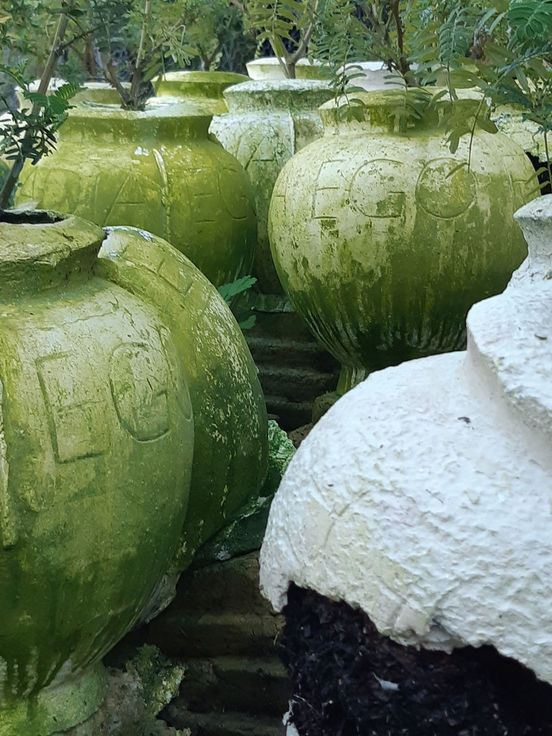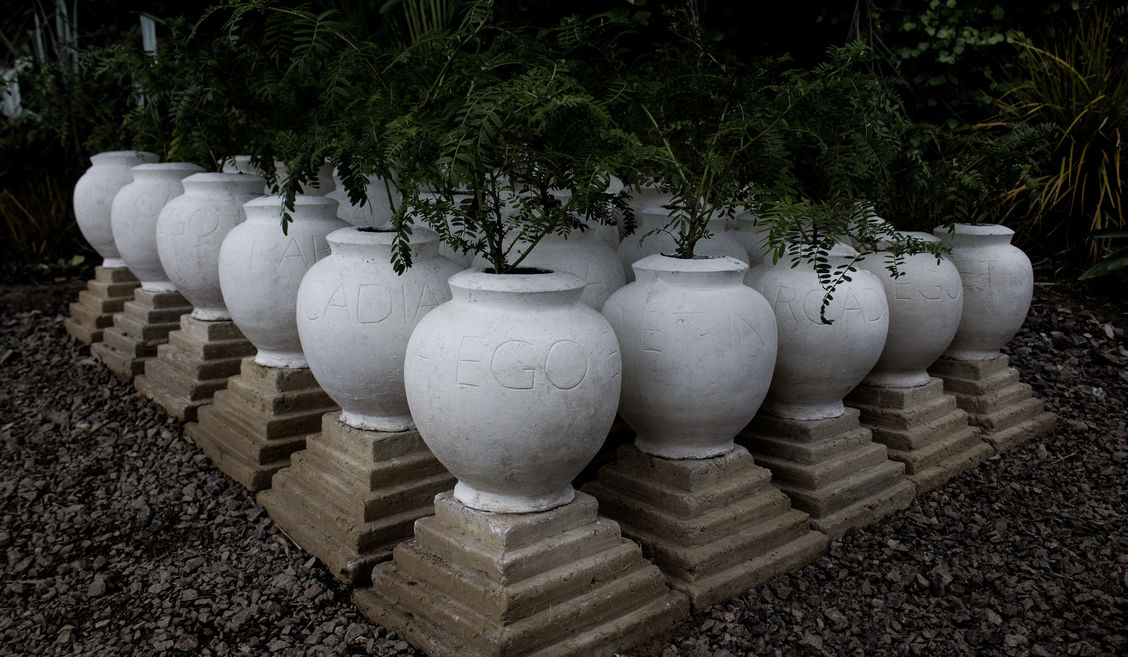-
Author
Melanie Oliver -
Date
8 Mar 2019
Essay
I Too Am in Paradise II
A Written Essay
I Too Am in Paradise II is a glimpse into the secret lives of plants. Over the course of nearly a year, Raewyn Atkinson used a time-lapse camera to document the growth of ngutu kākā mā ‘white kākā beak’ plants that she had potted in a cluster of unfired clay urns. Set in her garden in Te Whanganui-a-tara Wellington, the subsequent video shows aspects of a scene not usually observable in a still image: the slow, subtle processes of development and decay, circadian rhythms, and all manner of weather, from blustery winds and blotchy rain to occasional bursts of sun. The seasonal changes that the video reveals are challenging and nurturing in varying degrees; some plants thrive more than others, while the urns gradually disintegrate. The work quietly conveys these organic processes. Days are marked by light and dark, weeks and months by the blossoming of the ngutu kākā mā and slumping of the urns as they soften, crumble and return to the earth they came from. Time is amplified, palpable and poignant, as the work comes to represent our own life changes, the storms we weather and our ultimate mortality.
The title of Atkinson’s work reinforces this, appropriating a translation into English of the title of the memento mori painting Et in Arcadia ego (1637—38) by classical French Baroque artist Nicolas Poussin. Poussin’s work depicts a pastoral scene with several shepherds in discussion around a tomb. The painting has multiple potential meanings and has come to be seen as both a reflection on death and an allegory for the role of painting. Thematically, then, it is akin to Atkinson’s focus on the life of her plants and the clay urns’ eventual return to the earth. The urns are each adorned with the words ‘Et in Arcadia ego’. However, on the one situated at the front of the group only the word ‘ego’ can be seen, turning it into a statement on the conscious, thinking subject, on self-esteem and on personal identity. At one point in the video, the piece of this urn inscribed with text tumbles off, the moisture from the dirt finally breaking open the vessel. As the video continues, the earth and plant roots hold the urn’s shape, the memory of their recent encasement retained until the ngutu kākā mā can be planted out into a bigger patch of soil.
Poussin painted two works with the title Et in Arcadia ego, around ten years apart. The second version, completed in 1638, contains a depiction of what is traditionally considered the first image in the history of art: one of the shepherds notices his companion tracing the silhouette of his shadow on the tomb, a reference to the birth of painting. Atkinson too has made two works with ngutu kākā, initially installing planted urns in the courtyard of The Dowse Art Museum for an exhibition over summer 2017—18. In the second iteration at Objectspace, I Too Am in Paradise II, she has moved into video form to address the difficulties of exhibiting a living sculpture and to visually communicate the passage of time. As a video, the work incorporates the time-lapse image capture process as an integral part of it, another kind of reflection on the nature of art and image making.


It is the history of ngutu kākā mā that is especially critical for this work, though. There are two species of ngutu kākā that are threatened with extinction in the wild in Aotearoa New Zealand. Atkinson's project is inspired by a desire to both share this concern with a wider public and assist with the conservation of the ngutu kākā in a practical way. Her initial installation at the Dowse involved gifting the plants at the end of the exhibition to volunteer gardens around the Wellington region to increase the local population. At the conclusion of the second planting, of a rarer white variant, in her own garden, Atkinson will send the surviving shrubs to Dame Anne Salmond's Longbush Ecosanctuary in Gisborne, returning them to the region that the seeds were sourced from and where the need for their preservation is most vital.
The plants used in this project were entrusted to Atkinson by East Coast hapū Ngāi Kōhatu (Ngāti Hinehika), who are kaitiaki for the species. These kākā beak taonga are known at Te Reinga Marae as ‘ngutu kōrako’, named after the ancestress Hinekōrako, a taniwha who lives beneath Te Reinga falls. The English translation of kōrako is ‘albino’, which describes the white flowers of this type of kākā beak. The plant is woven into local history and narratives through this naming, highlighting its enduring significance. For example, Hine Kōrako is also one of three female atua ‘gods’ featured in the celebrated painting Kohine te iwaiwa, ko hine korako, ko rona whakamau tai (1993) by Robyn Kahukiwa, who also has whakapapa links to the area. Returning the plants to their original home, Atkinson acknowledges ngutu kākā mā as indigenous taonga and contributes towards their survival.
Thus the ecological, social and cultural importance of conserving ngutu kākā mā is at the heart of I Too Am in Paradise II. In capturing the struggles of developing these vulnerable plants from seed to shrub, the work stresses that preserving the ecodiversity of Aotearoa New Zealand against introduced species, disease and pests is an ongoing challenge. A rich green lichen gathers on the urns over the duration of the video, reinforcing that the clay earth used in their making — taken from the artist’s own garden —
is also an important resource, to be treated with respect.
Throughout her practice Atkinson has consistently aligned conceptual relevance with materials, delivering ideas through the specific history, nature and possibilities of the medium that she selects for each work. This project builds on that approach, broadening out from a sculptural installation caught on film to an ongoing conversation with a community, as Atkinson engaged with Ngāi Kōhatu (Ngāti Hinehika) and those for whom ngutu kōrako are part of their whakapapa. The work contemplates the continuing journey of the ngutu kākā mā plants, and in doing so provides a chance to think about our environment, the ways we respond to changes in climate, and how we adapt to circumstance.
—
Melanie Oliver is Senior Curator at The Dowse Art Museum in
Te Awakairangi Lower Hutt. She was Director of The Physics Room in Christchurch from 2012 to 2016, and has held curatorial roles at the Govett-Brewster Art Gallery in New Plymouth and Artspace Sydney. Melanie is currently a PhD candidate at Monash University in Melbourne.